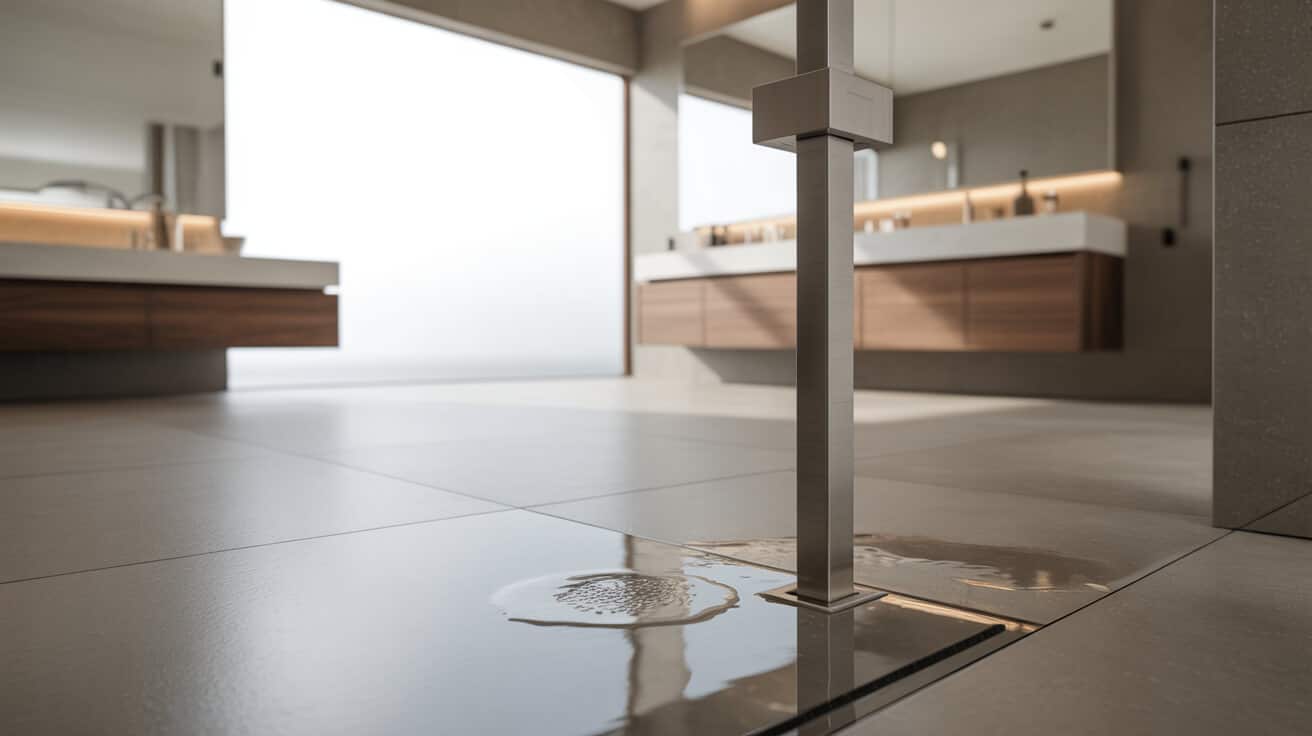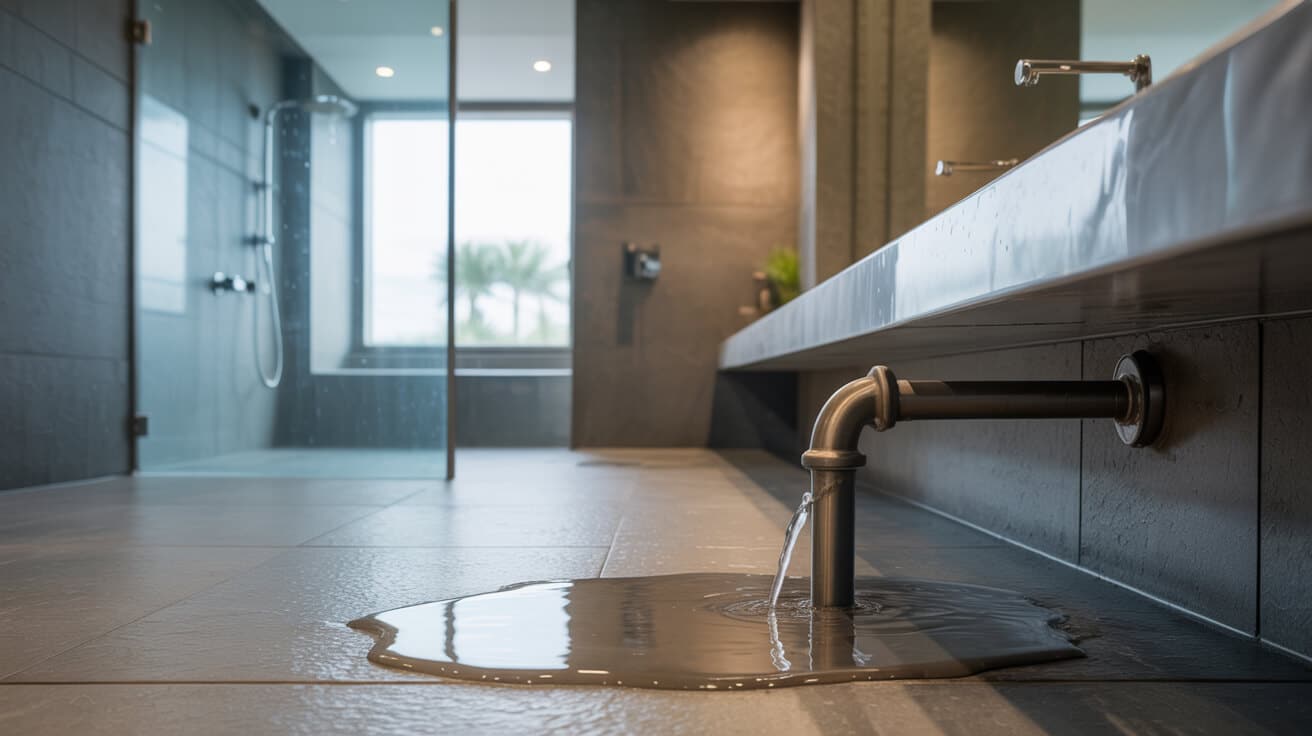The detection of leaks within plumbing and heating installations balances technical challenge and operational necessity. Even minor undetected leaks can escalate, eroding structural integrity, promoting mould growth, and increasing utility costs. Inhabitants, property owners, and managers rely on companies equipped with calibrated tools and specialised skills to maintain compliance, service continuity, and peace of mind. The integration of traditional craft and modern technology allows for minimally invasive investigation, addressing your needs regardless of property type or mechanical complexity.
Etymology or name origin
The word “leak” derives from Middle English leke—indicating unwanted escape—and the Old Norse leka. “Detection” combines Latin roots de-, meaning “off,” and tegere, meaning “to cover,” implying the act of uncovering. Together in technical vernacular, “leak detection” refers to the analytical and practical efforts required to identify sources of water loss in engineered systems.
Overview and context
Industry background
Leak detection forms a critical element of maintenance protocols in both residential and commercial environments. Regulatory codes, insurance stipulations, and water conservation initiatives underpin its prevalence, making your attention to early detection a prudent aspect of asset stewardship. The discipline exists at the crossroads of plumbing, environmental engineering, and property management.
Sectoral significance
Prompt identification of water leaks translates into tangible savings for you and your organisation, not only in avoided repair bills but also in maintained asset value and operational trust. Leaks rank among the foremost causes of recurring insurance claims and facilities downtime. As your environment grows in complexity—layered heating circuits, legacy water systems, and intricate waste networks—so too does the imperative for companies to deliver proactive, system-wide diagnostic services.
Preventive and reactive approaches
Companies such as Plumbers 4U engage in both scheduled, preventive sweep programmes and emergency response triage. Preventive efforts allow for progressive reduction in undetected loss, while reactive detection mitigates immediate and future complications. Each mode is selected according to your asset profile and risk exposure.
History
Early practices
Historically, leak discovery relied on the practised senses and experience of tradespeople: visible moisture, tactile cues, and auditory anomalies. Manual tracing of exposed pipe routes, visual inspection for joint dampness, and the application of basic isolation (system shut-offs) characterised the first generation of detection.
Technological developments
The 19th and 20th centuries introduced hydrostatic pressure testing, where water was trapped and monitored for pressure decay over time, and coloured dyes to identify slow leaks in waste or gravity systems. Acoustic technology enabled operators to listen for minute vibration changes, allowing detection through substrate or soil. These methods found a place in both routine pipework validation and the localization of active bursts.
Digital and smart era advances
Recent decades have witnessed rapid evolution: high-resolution thermal imaging for underfloor heating circuits, gas tracing for buried or inaccessible pipework, moisture mapping through digital sensors, and even camera-based endoscopy for enclosed cavities. Plumbing and heating companies today select from an arsenal of approaches, pairing your needs with the minimum disruption and optimum reliability.

Concept and description
Physical mechanisms
Leaks manifest when fluid escapes containment due to a breach—structural or component failure—along the pathway. Causes include:
- Corrosion: of metallic pipework or fittings
- Material fatigue: from cyclical pressure/temperature changes
- Joint failure: at mechanical connections
- Impact or accidental damage: (renovation, improper installation)
- Environmental triggers: such as freeze-thaw cycling
Typical locations in systems
- Pressurised pipework (copper, plastic, composite)
- Fittings: soldered joints, compression, push-fit
- Isolation valves and stopcocks
- Appliances: water heaters, unvented cylinders, washing machines
- Underfloor heating circuits and manifolds
- Waste/soil pipes and traps
Indicators and symptoms
Leaks may reveal themselves through:
- Fluctuating metre readings or unexplained usage spikes
- Persistent damp patches, staining, or discoloration
- Audible dripping or flowing within walls or under floors
- Mould, algae, or mildew along baseboards and corners
- Lowered system pressure, inability to maintain heating output, or erratic hot water supply
Consequences of undetected leaks
- Structural damage (timber rot, concrete degradation)
- Deterioration of finish materials (plaster, paint, flooring)
- Escalated bills, particularly in metered properties
- Potential health hazards from mould proliferation
- Insurance complications or disputes regarding pre-existing damage
- Tenant dissatisfaction and reputational risk for your organisation
Functionality, purpose, and applications
Domestic property management
Leak detection is fundamental to preserving the integrity and value of your residence or managed units. Early intervention limits the spread of water damage, minimises repair costs, and ensures compliance with your insurance and warranty requirements.
Commercial and industrial applications
Facility managers and business owners rely on structured detection programmes to secure uninterrupted operations. In environments with high water use or distributed mechanical networks—such as hotels, schools, or industrial premises—consequential risk is heightened. Failures may propagate far from the source, necessitating zone-based diagnostic strategies and comprehensive recordkeeping.
Public and landlord obligations
Your statutory duties as a landlord or public building operator mandate habitable, safe premises. Regulations frequently specify response timelines for plumbing faults. Maintenance logs and trace-and-access reports, prepared by companies such as Plumbers 4U, provide proof of due diligence for legal and insurance matters.
Routine maintenance vs. emergency response
Proactive detection—via schedule-based checks—delivers compound value. Emergency interventions target sudden losses, safeguarding against rapid escalation and mitigating secondary harm such as electrical shorting or localised flooding. Each scenario demands calibrated deployment of technology and careful documentation.
Classifications and types
Leak location typology
- Pressurised supply-side: leaks: typically high volume, rapid propagation, urgent risk
- Heating system leaks: occur in wet radiator loops, underfloor heating, or at boiler/cylinder interfaces
- Appliance or connection leaks: involve secondary fixtures or user-serviceable points
- Drainage/waste leaks: may be gravity-driven, latent, or exposure-prone—often detected post-factum by odour, damp, or substrate decay
Symptomatic vs. latent leaks
- Symptomatic: visible, audible, or detected via system pressure loss
- Latent: hidden in inaccessible cavities, under screed, or within wall structures; manifest through secondary symptoms like mould or building movement
Single- vs. multi-system leaks
- Single-system: localised to one network (e.g., hot water supply, underfloor heating manifold)
- Multi-system: impact across plumbing, heating, and drainage simultaneously, often due to construction errors or wide-scale corrosion
Special cases: underfloor and cylinder leaks
- Underfloor heating circuits and high-pressure unvented cylinders present greater detection challenges owing to concealment and safety risks; professional surveillance is required for both initial diagnosis and post-repair verification.
Detection methods and tools
Visual and manual inspection
- Moisture trails and discoloration
- Surface dampness or substrate softening
- Physical testing of accessible joints, valves, and pressure points
- Progressive isolation to segment affected circuits
Instrumental technologies
- Pressure decay/retention test: confirms presence of leak via sustained measurement post-isolation.
- Digital moisture metres: determine latent water presence in floors, walls, and structures.
- Acoustic/ultrasonic detectors: detect turbulence/vibration from escaping fluid in buried or encased pipework.
- Thermal/infrared imaging cameras: reveal temperature deviations linked to heat loss or evaporative cooling from water release.
- Tracer gas detection: introduce safe gas (hydrogen/nitrogen blend), trace via sniffer for precise source mapping.
- Endoscope/borescope inspection: insertable cameras for visual confirmation in voids, ductwork, and behind panels.
- Dye tracing: harmless coloured or fluorescent agents to prove waste/leakage path in gravity or low-pressure systems.
| Detection Method | Best Use | Limitations |
|---|---|---|
| Visual Inspection | Surface leaks | Misses hidden/cavity leaks |
| Pressure Test | Pressurised net. | Not localising, identifies only presence |
| acoustic detection | Buried pipes | Requires expertise, false positives in noise |
| Infrared Imaging | UFH/Radiators | Not suitable for all floor/wall types |
| Tracer Gas | Concealed lines | Intrusive, rarely for waste/drainage |
| Endoscopy | Cavities/drains | Limited by access, small entry holes needed |
| Dye Testing | Waste appliances | Not useful for closed pressurised pipes |
Smart/connected devices
In select scenarios (portfolio buildings, commercial spaces), companies may deploy networked moisture sensors and real-time data logging as early warning systems, contributing to overall risk management protocols.
Comparative method limitations
Each detection strategy must be matched to your building age, pipework material, system type, and diagnostic urgency; hybrid approaches are regularly used for conclusive results.

Stakeholders and entities involved
Service providers
Licenced plumbing and heating companies specialising in leak detection, including all-in-one firms such as Plumbers 4U, deliver end-to-end survey, diagnosis, and documentation solutions. Multidisciplinary teams may include certified installers, technical surveyors, and compliance officers.
Regulatory bodies
National and regional authorities, including building control, water suppliers, and organisations like WRAS, enforce detection methodology standards, minimum training, and consumer protection protocols.
Property stakeholders
- Homeowners: seek to preserve asset value and minimise disruption
- Landlords: maintain compliance and avoid claims
- Facility managers: safeguard users, manage operational integrity, and sustain certifications
- Occupants/tenants: expect timely action and quality outcomes
Insurance and assessment parties
Providers require detailed, timestamped documentation and, where necessary, independent assessment to process trace-and-access or escape-of-water claims. Your compliance with best-practice reporting expedites compensation and limits liability exposure.
Emerging participants
An increasing range of third-party asset managers and surveyors assist in large-scale facility risk management, leveraging technological advances and best-practice reporting structures.
Legal, regulatory, and ethical considerations
Building regulations and codes
Companies must observe statutory provisions such as:
- UK Part G: Ensuring hot water and sanitation system safety, preventing scalding, and requiring certification for certain installations.
- Part H: Mandating proper drainage, venting, and backflow protection.
- Part L: Setting expectations for energy conservancy, insulation, and pipework efficiency.
Trace and access: insurance perspectives
Documented, professional detection procedures underpin insurance claims. Insurers routinely require photographic evidence, system logs, and certified technician reports as produced by service providers such as Plumbers 4U.
Landlord and facility requirements
Landlords are legally obligated to repair leaks within regulated timeframes and provide system documentation; housing and workplace statutes support tenant claims for remedy and compensation.
Smart technology: privacy/data security
Where monitoring extends into behavioural or property data (e.g., continuous logging, occupancy-based leak alarms), companies must enact strict privacy controls and transparent retention/use policies for your building, business, or home.
Performance metrics and measurements
Technical key performance indicators
- Detection accuracy: successful pinpointing vs. false positives/negatives
- Response speed: time from notification to confirmed finding
- Minimally invasive outcomes: percentage of successful non-destructive localizations
- Remediation success: resolution rates and post-repair assurance
Customer experience markers
- Clarity: Consistency and completeness of communication from initial contact to follow-up
- Speed: Timely response and restoration
- Aftercare: Ongoing support, service guarantees, and education where appropriate
Risk reduction and compliance scoring
Quantifying reductions in unscheduled downtime, unresolved claims, and repeated incidence provides a benchmark for continuous improvement in company and sector practices.
Challenges, barriers, and limitations
Operating environment issues
Multistory, mixed-use, or legacy properties can stymie even skilled investigation. Encased, hidden, or non-standard piping demands creative adaptation and, at times, selective intrusive access.
Technology limitations
Device calibration, operator skill variance, building material interference, and the risk of false positives mean no tool is uniformly effective. Seasonal variation can further complicate reliable diagnosis.
Budget constraints influence the adoption of preventive checks, sometimes prompting deferred maintenance and larger eventual cost. Tenant hesitancy or poor property management communication can result in unchecked damage, while insufficient training leads to inconsistent service delivery.
Impact, influence, and legacy
Industry impact
Systematic leak detection has transformed your expectations of maintenance: moving from reactive, damage-driven repair to predictive risk management. Through rigorously applied diagnostics, companies such as Plumbers 4U raise standards for accountability, asset longevity, and sustainability.
Environmental and public health outcomes
Optimised, early detection directly supports conservation imperatives and public health. Efficient response lessens mould and moisture-related illnesses, reduces wastage, and maintains high indoor air quality.
Social value
Leak detection is increasingly perceived as an indicator of responsible property stewardship and contemporary service professionalism, engendering trust and satisfaction for all parties involved.
Future directions, cultural relevance, and design discourse
Non-invasive technologies, algorithm-driven pattern recognition, and continuous improvement in imaging and acoustic resolution will shape the coming years. Regulatory and cultural norms are converging on transparency, regularised inspection, and shared stewardship models between providers and customers. Professional plumbing and heating companies, by integrating process transparency and technical depth, set new expectations for how property risk is understood, managed, and resolved.

